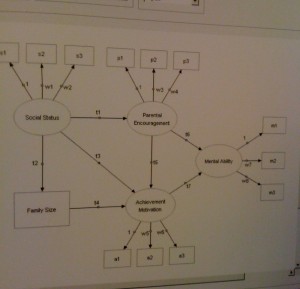A few statistical details on JMP’s pointy-clicky SEM
The new structural equation modeling for JMP is pretty cool. It’s unfortunate that it requires both JMP and SAS/STAT to run it, the cost of the two combined being so expensive that you pretty much have to work for a huge organization that can afford a site license for both or sell a kidney to get the money to pay for it.
If you have read this far, I am going to presume that you have sold your soul to the corporate overlords (or university overlords and don’t pretend it isn’t the same thing) and have access to both site licenses. Either that, or you have an extra kidney. Whatever.
I did write about some of the pointing and clicking a few days ago, but that post was getting long and I was running out of Chardonnay, so I left off the statistical details for another day, and I just realized – hey, it’s another day!
Completely random statistical points:
It uses PROC CALIS. This is why you have to have SAS/STAT installed.
 This is actually a good thing (other than the need for a briefcase full of cash), because there is a ginormous load of detailed documentation on PROC CALIS, starting with the the SAS/STAT manual. I’d never before encountered funding agencies asking for the equations used for a procedure, e.g., if you said you were doing a logistic regression using statistical package X, that was good enough. Twice this year, I have been working on proposals where they really did want that level of detail, and I recently saw another proposal that included that information, so I’m assuming they had the same experience. Either that or they just had a lot of spare time on their hands.
This is actually a good thing (other than the need for a briefcase full of cash), because there is a ginormous load of detailed documentation on PROC CALIS, starting with the the SAS/STAT manual. I’d never before encountered funding agencies asking for the equations used for a procedure, e.g., if you said you were doing a logistic regression using statistical package X, that was good enough. Twice this year, I have been working on proposals where they really did want that level of detail, and I recently saw another proposal that included that information, so I’m assuming they had the same experience. Either that or they just had a lot of spare time on their hands.
It seems rather a bizarre turn of events to me, but, then, maybe not. If you’re counting on these results to make policy, you ought to know how they are produced other than a black box. All of the statistical theory and equations behind CALIS output are available to anyone who has Internet access.
As you’d expect, you can get both standardized and unstandardized parameter estimates.
There are six estimation methods, including full information maximum likelihood (for more about FIML, you can see an earlier post “Damn! There really IS structural equation modeling for dummies!” )
There are a bunch of model fit statistics available and you can modify your user profile to only show your favorite ones each time. That JMP assumes you will HAVE favorite model fit statistics tells you all you need to know about their target market.
Saying it’s just like CALIS is pretty useless to you if you aren’t familiar with that procedure, so here are a few more bits about it
You can do a regular path analysis, just don’t include any latent variables
You can do confirmatory factor analysis, just don’t have any paths among latent constructs and set your number of latent constructs to be your number of hypothesized factors. If you want orthogonal factor analysis, set the covariance between the factors to zero.
Don’t be fooled by all the pointing and clicking and photoshop-like options such as increasing the canvas size so you can have a larger drawing area for your model. JMP’s new SEM interface may not require coding a series of equations like CALIS or LISREL but it is not to be confused with a tool that can be used by your average graphic designer (sorry average graphic designer people). It still requires some knowledge of what is an exogenous variable, endogenous variable, indicator, latent construct, model fit statistics, standardized versus unstandardized parameter estimates and estimation methods, just for a start.
For some (but not all) of the elements required, it has defaults, so you could possibly get a model to run without really knowing what you’re doing but I really, really wouldn’t recommend it. (If you ignore my advice, do it anyway and end up looking like an ass, don’t say I didn’t warn you.)